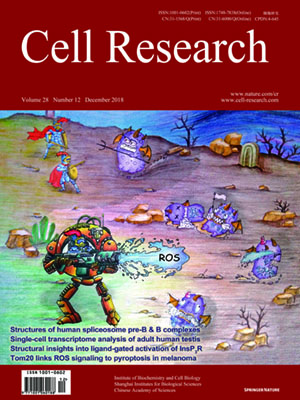
Volume 28, No 12, Dec 2018
ISSN: 1001-0602
EISSN: 1748-7838 2018
impact factor 17.848*
(Clarivate Analytics, 2019)
Volume 28 Issue 12, December 2018: 1158-1170
ORIGINAL ARTICLES
Cryo-EM reveals ligand induced allostery underlying InsP3R channel gating
Guizhen Fan 1, Mariah R. Baker 1, Zhao Wang 2, Alexander B. Seryshev 1, Steven J. Ludtke 2, Matthew L. Baker 2 and Irina I. Serysheva 1
1Department of Biochemistry and Molecular Biology, Structural Biology Imaging Center, McGovern Medical School at The University of Texas Health Science Center at Houston, 6431 Fannin Street, Houston, TX 77030, USA and 2Verna and Marrs McLean Department of Biochemistry and Molecular Biology, CryoEM and CryoET Core, Baylor College of Medicine, One Baylor Plaza, Houston, TX 77030, USA
Correspondence: Correspondence: Irina I. Serysheva (irina.i.serysheva@uth.tmc.edu)These authors contributed equally: Guizhen Fan and Mariah R. Baker
Inositol-1,4,5-trisphosphate receptors (InsP3Rs) are cation channels that mobilize Ca2+ from intracellular stores in response to a wide range of cellular stimuli. The paradigm of InsP3R activation is the coupled interplay between binding of InsP3 and Ca2+ that switches the ion conduction pathway between closed and open states to enable the passage of Ca2+ through the channel. However, the molecular mechanism of how the receptor senses and decodes ligand-binding signals into gating motion remains unknown. Here, we present the electron cryo-microscopy structure of InsP3R1 from rat cerebellum determined to 4.1 Å resolution in the presence of activating concentrations of Ca2+ and adenophostin A (AdA), a structural mimetic of InsP3 and the most potent known agonist of the channel. Comparison with the 3.9 Å-resolution structure of InsP3R1 in the Apo-state, also reported herein, reveals the binding arrangement of AdA in the tetrameric channel assembly and striking ligand-induced conformational rearrangements within cytoplasmic domains coupled to the dilation of a hydrophobic constriction at the gate. Together, our results provide critical insights into the mechanistic principles by which ligand-binding allosterically gates InsP3R channel.
https://doi.org/10.1038/s41422-018-0108-5
FULL TEXT | PDF
Browse 1220


